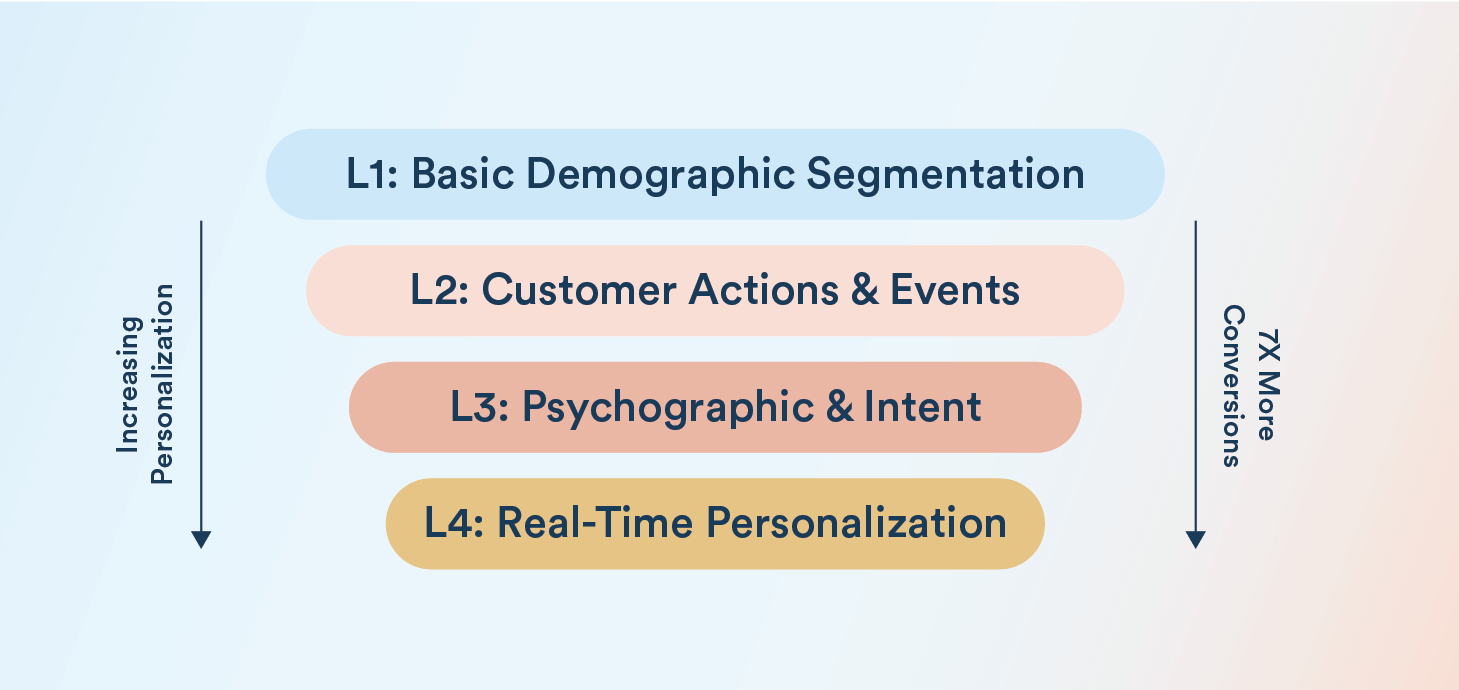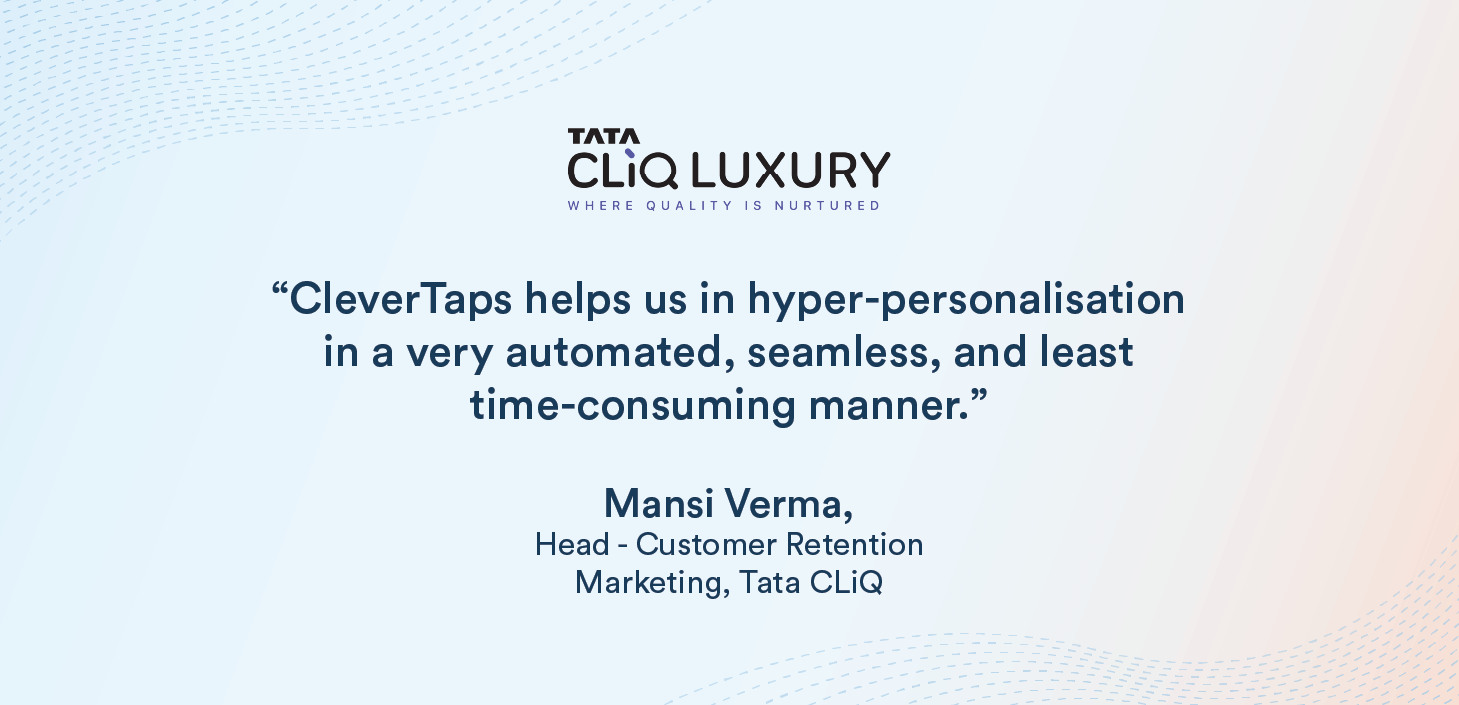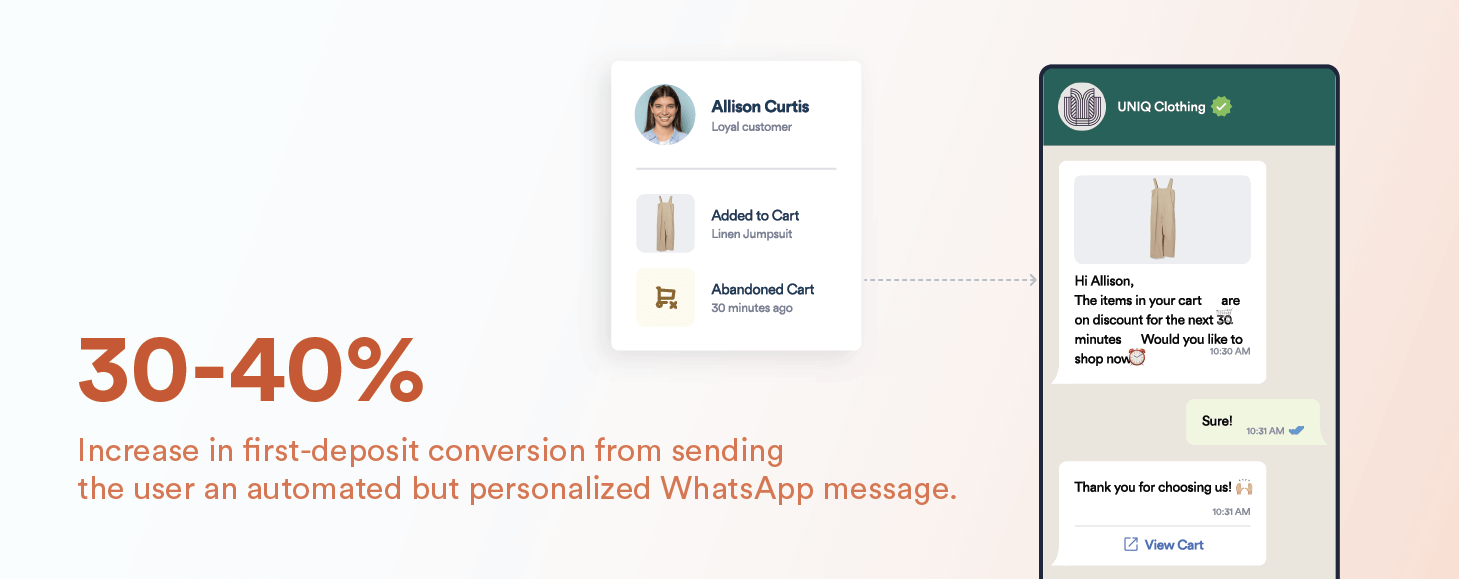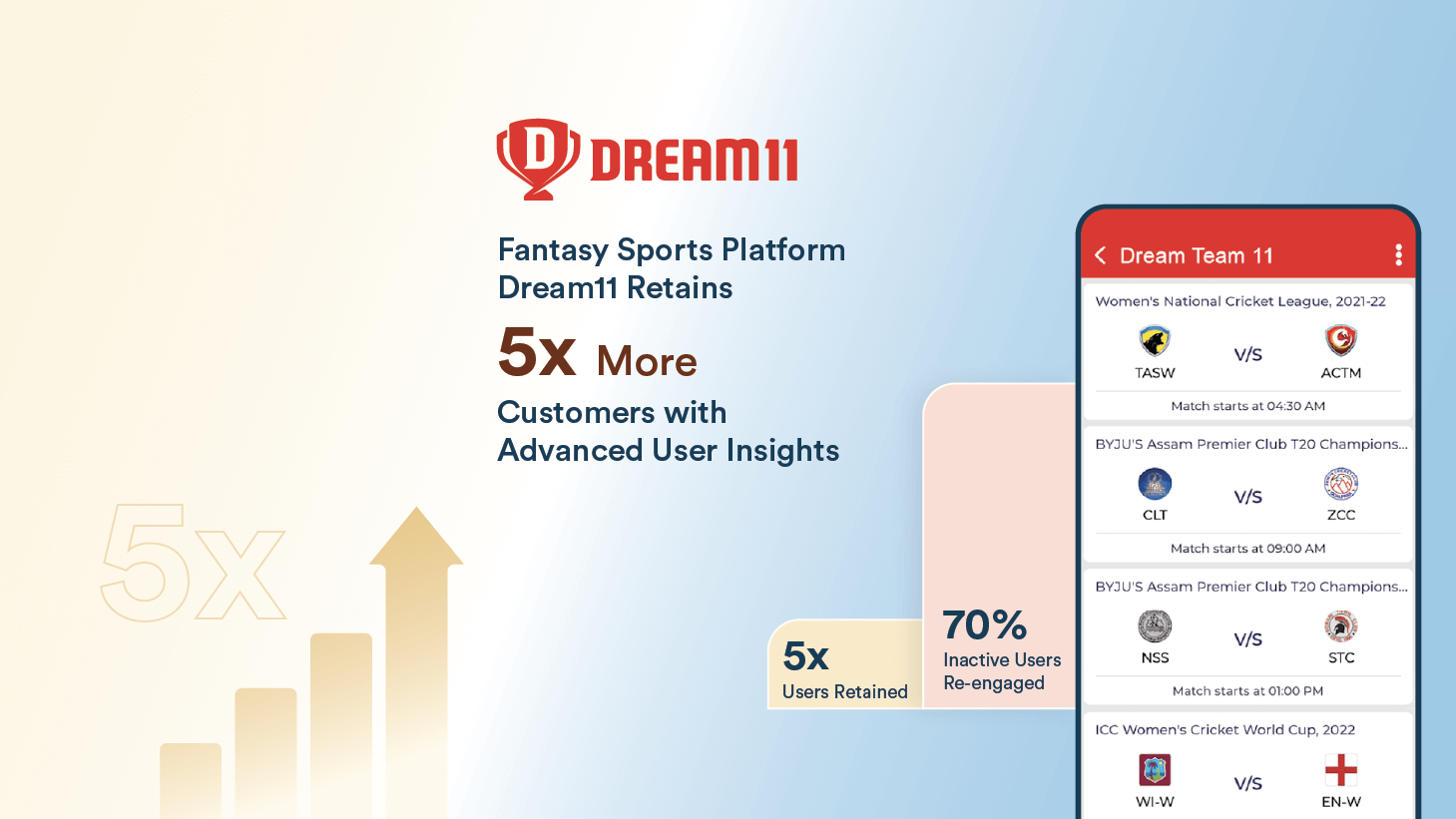Hyper-personalization is a marketing marvel that makes consumers feel like brands are reading their minds. In this blog, we’ll unravel how it works and how truly knowing your audience can turning fleeting interactions into lasting customer relationships.
Today’s customers expect much more than just a one-size-fits-all approach.
Against the life-altering backdrop of the global pandemic and the rapid shift to all-things-digital, basic personalization has given way to individualization. Extreme customer-centricity is the new normal and an absolute must to be competitive in today’s digital marketplace.
Consider this study by McKinsey: 71% of consumers said that they expect companies to deliver personalized experiences, and when the brand doesn’t, 76% get frustrated and will seek what they need elsewhere.
This shift in expectations has ushered in a new reality. Personalized offers and effortless interactions across all devices are now an industry standard, and customers don’t just want them —they expect them.
Hyper-personalization helps you meet these rising expectations by delivering highly relevant content, offers, and interactions that speak to each user’s personal needs and values. It makes customers feel valued and understood, building long-term relationships.
What is Hyper-Personalization?
Hyper-personalization is an advanced marketing strategy that goes beyond traditional personalization by using real-time data and AI to deliver highly individualized experiences.
Unlike basic personalization, which might involve addressing a customer by their first name, hyper-personalization uses extensive data points to tailor content, offers, and interactions to each user’s specific needs and preferences.
It is the most advanced approach brands can use to tailor their marketing to individual customers, ensuring that companies send customers the right messages at the right time and through the right channel.
Hyper-Personalization: Three Core Principles

This shift in how we envision and create a deeply personalized customer experience is embodied by three core principles:
- Segment of One: This refers to a brand’s ability to serve every consumer as an individual at every touchpoint of their journey with the brand.
- Predicting Consumer Needs: Rather than marketing engagement based on past behavior, hyper-personalization requires anticipating and addressing the future needs of customers. It’s about giving each customer what they are looking for when they visit your website or app.
- Real-Time Engagement: Customers now expect relevant engagement on their preferred channels in real time while they’re using your app. Unfortunately, this is not an easy problem to solve.
Why Hyper-Personalization Matters
Here are a few of the many ways hyper-personalization can supercharge growth and elevate your brand:
Enhanced Customer Experience
Hyper-personalization takes customer experience to a whole new level. By leveraging detailed customer data, you can tailor every interaction to meet individual preferences and needs. This means your customers feel understood and valued, which significantly improves their overall experience. Imagine receiving product recommendations that align perfectly with your tastes or getting personalized content that speaks directly to your interests. This level of customization makes your customers’ journey more enjoyable and engaging.
What’s more, it helps you interact with your customers in a way that is appropriate to where they are in their journey. This is important because there’s no longer just just one customer journey. Instead, each customer’s path is unique and idiosyncratic, with nuances based on how and where they entered the funnel.
Improved Customer Loyalty and Brand Affinity
When customers feel a brand truly understands them, they are more likely to stay loyal. Hyper-personalization fosters a deeper connection between your brand and your customers. By consistently delivering relevant and personalized experiences, you build trust and loyalty. This not only keeps your customers coming back but also turns them into brand advocates who are more likely to recommend your products or services to others. In a competitive market, this loyalty can be a game-changer.
Competitive Advantage
In a crowded market, standing out is essential. Hyper-personalization gives you a significant edge over competitors who rely on traditional methods. By leveraging advanced data analytics and machine learning, you can create unique experiences that resonate deeply with your audience. This not only attracts new customers but also keeps existing ones coming back.
Customer Engagement and Retention
Engagement and retention are key metrics for any business, and studies have repeatedly shown that it costs far more to acquire customers than to retain them. This new dynamic is making retention marketing the most critical function, surpassing all others in determining a company’s ability to grow and thrive.
Hyper-personalization directly impacts these metrics by making every interaction meaningful. Customers who receive personalized recommendations, timely offers, and relevant content are more likely to engage with your brand. This increased engagement leads to higher retention rates, as customers are more likely to stay loyal to a brand that consistently meets their needs.
And, because this advanced form of personalization is so effective at fostering engagement and loyalty over time, it’s a virtuous cycle: Repeat transactions generate more data that companies can use to personalize.
- Enhanced Customer Experience: Tailored interactions make customers feel special.
- Increased Loyalty: Personalized experiences foster stronger emotional connections.
- Higher Conversion Rates: Relevant offers and recommendations lead to more sales.
Simply put, when you invest in hyper-personalization, you’re setting your business up for long-term success.
Hyper-Personalization Examples

E-commerce
In the world of e-commerce, hyper-personalization can transform the shopping experience. Imagine logging into your favorite online store and being greeted with product recommendations that feel like they were picked just for you. This isn’t magic; it’s hyper-personalization at work. By analyzing a customer’s browsing history, past purchases, and even the time they spend looking at certain items, e-commerce platforms can tailor offerings to suit their unique preferences.
For instance, if a user frequently buys running shoes, the platform might suggest the latest models or accessories like running socks and fitness trackers. They might also send you personalized emails with exclusive discounts on your favorite brands. This level of customization not only makes shopping more enjoyable but also increases the likelihood of repeat purchases.
Healthcare
Hyper-personalization can also significantly improve patient outcomes in the healthcare sphere. By leveraging data from electronic health records, wearable devices, and patient surveys, healthcare providers can offer highly personalized treatment plans. For example, a patient with diabetes might receive tailored advice on diet and exercise based on their blood sugar levels, activity data, and even genetic information.
Moreover, personalized reminders for medication, appointments, and lifestyle changes can be sent via text or email, ensuring that patients stay on track with their treatment plans. This proactive approach not only enhances patient engagement but also helps in the early detection and prevention of potential health issues.
Financial Services
Hyper-personalization can help customers in the financial sector manage their finances more effectively. Banks and financial institutions can analyze their spending habits, investment preferences, and financial goals to offer customized advice and products. For instance, if a user frequently travels internationally, their bank might suggest a credit card with travel rewards and no foreign transaction fees.
Additionally, personalized financial planning tools can help users set and achieve their financial goals. Whether it’s saving for a house, planning for retirement, or managing debt, these tools can provide tailored recommendations based on their unique financial situation. This not only helps them make informed decisions but also builds trust and loyalty with their financial institution.
Hyper-Personalization with CleverTap: Measurable Gains and Sustainable Growth
Success in any competitive environment has always depended on building long-term relationships, and hyper-personalization is the foundation on which these relationships must be built and maintained.
At CleverTap, we believe prioritizing hyper-personalization and making a concerted effort across all touch points is a cornerstone for success and sustainable growth.
How is this accomplished?
The first step is getting rid of the old personalization playbook. Instead of channeling money and resources into filling the funnel, companies should be laser-focused on what will keep customers coming back and making repeat purchases.
Your marketing and communications must be able to quickly adapt to each individual customer’s unique needs, which constantly shift with the context and the moment in time.
This is the essence of hyper-personalization: the ability to treat customers as individuals. In today’s hyper-competitive, customer-centric environment, the ability to do this successfully sets your brand apart.
Unlock your brand’s unrealized growth potential with hyper-personalization.
A Multitiered Approach to Hyper-Personalization
CleverTap’s dynamic approach to personalization encompasses four distinct levels, each with its own unique value and specific use cases in the e-commerce world. Here’s a breakdown:

Level 1
Uses demographic data like age, gender, and location to tailor recommendations and promotions, making sure content is relevant to different customer segments. For example, promoting winter clothing to customers in colder regions or highlighting events in specific cities can make marketing efforts more relevant.
Level 2
Focuses on behavior-based segmentation, creating messages based on past customer actions and events, such as browsing history and purchase behavior. Personalized recommendations and re-engagement campaigns, such as reminding customers of abandoned carts or promoting clearance sales at nearby stores, can significantly enhance the customer experience.
Level 3
Predicts customer preferences and intent, customizing content and offers to match their interests and likely future actions. For example, fashion enthusiasts can receive recommendations for the latest trends, while tech-savvy customers might be targeted with offers on new gadgets. Tailoring the content experience to specific psychographic profiles deepens customer engagement and fosters loyalty.
Level 4
Utilizes real-time data to trigger immediate, highly relevant messages based on current behaviors and events, enhancing the customer experience with timely engagement. Event-driven campaigns and urgency messaging, like highlighting trending items or limited-time offers, can create a sense of immediacy and encourage quick purchasing decisions. Real-time personalization maximizes the relevance of interactions, providing a seamless and responsive customer experience.
Implementing these levels of personalization makes shopping more compelling and customer-focused, driving higher engagement and conversions. Our data shows that moving from just using Level 1 personalization to incorporating all four levels exponentially boosts conversion rates, proving the power of a comprehensive personalization strategy.
See how CleverTap can help you build hyper-personalized customer experiences that drive engagement and loyalty.
Customer Case Studies
The following are some real-world customer stories that show how other brands are using hyper-personalization to capture more market share.
Dream11: Supercharging Rules-Based Marketing to Win at Fantasy Gaming
Dream11 is a fantasy sports platform based in India. The app boasts 130 million users—an astounding 10% of India’s population. The company gained tens of millions of users and overcame the challenges of user retention by perfecting the user experience.
Creating Hyper-Personalized Customer Experiences
For Nikhil Lalvani, Director of Product Management at Dream11, creating hyper-personalized customer experiences “has been super critical in keeping our users on the app and for allowing us to serve them the things that they need at the right time, contextually.”
Having so many users brings particular challenges because their users will all have varying needs. For Lalvani, this means constantly asking, “How do we make them value their experience with Dream11 a lot more?” Similarly, when there are so many different segments of users, each needs to be treated based on the characteristics of that particular segment for the most effective engagement.
Creating Contextual Communication
This is done by using a rules-based engine to send out hyper-personalized communications based on pre-defined triggers.
The company identifies the user’s journey stage, the players and sports they like, if they have a friend network established, etc. These are then used to trigger communications for each user, at the right time and in the most contextual way possible.
Crushing Churn
Lalvani notes that churn is one of those challenges that truly requires a holistic approach to solve it effectively. First, they identify the reasons for churn and try to course-correct before the user is lost.
For users who do churn, they look at their past playing patterns and preferences and the sports calendar. If, for example, an inactive user is a Chelsea fan, they try to re-engage them by letting them know when Chelsea is playing next.
Takeaways From Dream11’s Strategy
- Always think about the value you are providing
- Segment and address each segment’s particular needs based on data
- Create hyper-personalized customer experiences for each segment
- Identify and address churn before it occurs

From Browsing to Buying: How Tata CLiQ Uses Data to Segment Audiences and Fuel Growth

Tata CLiQ Luxury is India’s premier luxury lifestyle brand, offering electronics, furnishings, home goods, designer apparel, jewelry, and more. Since the beginning of the pandemic, Tata CLiQ has seen its average order value increase 10-12%, with certain categories, such as high-end watches, growing 300-400%.
How did this brand succeed where others failed? According to Mansi Verma, Head of Customer Retention Marketing at Tata CLiQ, they tapped into hyper-personalization to provide real-time product recommendations that convert shoppers to buyers.
Browsers vs. Buyers: Data Tells You Which is Which
Data is key to creating more personalized experiences, particularly behavioral data that can differentiate between browsers and buyers. Tata CLiQ looks at things like the amount of time a user spends browsing products, the number of products they look at, whether they’re comparing multiple products with different price points, etc.
The company also looks at the user’s funnel stage and where they dropped off—was it from the homepage, a category page, or a product page? All of this data provides rich insights into what the user is looking for on the site.
Omnichannel Campaigns Help Reduce Cart Abandonment
To reduce cart abandonment, the company reaches out via a push notification. If a user doesn’t have push notifications enabled, they utilize email, SMS, and WhatsApp.
Tata CLiQ found that sending WhatsApp messages, in particular, has helped support its growth. According to Verma, “The click rates and conversion rates that we observed on WhatsApp are really amazing!”
Focus on Retention
To improve retention, Tata CLiQ knows that a one-size-fits-all strategy will not suffice. So, they split their customer base into sub-cohorts and segments based on the recency of purchase, the user’s previous purchase behavior, and more.
The company also looks at a customer’s behavior and interests outside of the Tata CLiQ Luxury universe, such as who the user follows on social media and what apps they engage with. Then, based on this more complete persona of the user, which is not just limited to Tata CLiQ Luxury, they create personalized communications, journeys, and offers.
Learn from Tata CLiQ’s Approach
- Use behavioral data to learn about your customers
- Differentiate between mere browsers and buyers
- Take an omnichannel approach to address cart abandonment
- Segment narrowly and create personalized communications, journeys, and offers for each segment
How CleverTap Supports Hyper-personalization
CleverTap has a number of features that support hyper-personalization. User profiles can store unlimited data points going back as far as ten years. This provides marketers with comprehensive historical data they can use to add unprecedented levels of personalization to the customer experience.
CleverTap also enables real-time personalization based on user actions. For example, Tata CLiQ uses events and Liquid Tags to ensure they show the right product recommendations to the right shoppers in real time,
Any user activity in the app is passed on to the CleverTap platform as an event, which is then used to create triggers or to automate and record campaigns. So, if a user is browsing a bag but drops off without making a purchase, this event is passed to CleverTap. Within 30 minutes, an automated push notification is sent to that user highlighting the bag they were looking at.
The entire messaging can be personalized—from the coupon code to the creatives used—based on the category that the user was browsing. Even the push copy will be different, for example, for someone browsing women’s wear versus men’s wear.


Using Hyper-Personalization to Educate, Drive Inclusion, and Ignite Growth
One goal of the fintech industry is to make financial services more accessible to the general public. Those who succeed understand that customers come to them to improve their lives by gaining access to tools and services that give them greater financial freedom.
Sumer and Guru Investimentos, two CleverTap customers in Latin America, are raising the bar for these services while leveling the playing field for their users. Here’s their approach.
Guru: Personalization is Adding a Human Touch
Guru Investimentos is a fintech company that bets on technology and design to simplify stock investing, challenging traditional brokerages. With more than 300,000 users, Guru enables consumers to buy and sell shares without a brokerage and without a minimum deposit.* The app also includes market information such as news, charts, and real-time quotes.
Guru has many different types of investors: those who have never invested, those who invest only in stocks, and those interested in crypto. To support retention, the company uses hyper-personalization to educate each segment about the other types of assets that they can also invest in.
Due to legalities, their registration process requires nearly 60 different data fields to open an account. Every time someone drops off, they send a very personalized message mentioning the field at which they dropped off. This way, they can come back and resume where they left off.
Guru adds a human touch when encouraging new users to make their first deposit, which is one of their biggest challenges. Sending the user an automated but personalized WhatsApp message has been very effective and has increased that first-deposit conversion by 30-40%.
Sumer: Hyper-Personalization Supports Growth
Sumer is a Colombia-based company with a super app that they hope will address the lack of technology hampering opportunities in Latin America and the Caribbean. They offer a variety of services, such as ecommerce, payments, logistics, advertising, and more. Their main product, however, is an online store that can be built in 15 seconds by simply uploading some photos along with a product description and other details.
Sumer relies on hyper-personalization not only for engagement but also to support growth. Analytics helps them understand users and their behaviors in the different countries they serve so they can adapt how they sell their product to various audiences.
They emphasize the importance of maintaining a two-way dialogue with customers by reaching out via WhatsApp or other communication channels. The more a brand can listen and truly understand how users are using a product, the easier it will be to make the kinds of improvements that will benefit them and ultimately retain them.
Key Takeaways
- Hyper-personalization, based on data, is key to retention and growth!
- A human touch is always a positive
- Establishing a two-way dialogue with customers helps you better understand and serve them


CleverTap supports WhatsApp messages in Journeys. Learn more about it here.
Hyper-Personalization Is Your Competitive Edge
Hyper-personalization is a powerhouse marketing tool that has become the gold standard across industries to improve the customer experience and ultimately build customer loyalty. This new mandate is being recognized as the way forward for any brand that wants to set itself apart from its competitors. Its creation and popularity have been driven by changing customer attitudes and expectations for marketing and messaging that speaks to each person’s unique needs and desires at a given moment.
For the end user, hyper-personalization ensures that messaging is highly relevant and contextual, as well as appropriate to where he or she is in their journey with your brand. For the brand, it’s the ultimate solution to the challenge of how best to increase user engagement and retention. It truly is that simple.
Subharun Mukherjee 
Heads Cross-Functional Marketing.Expert in SaaS Product Marketing, CX & GTM strategies.
Free Customer Engagement Guides
Join our newsletter for actionable tips and proven strategies to grow your business and engage your customers.
















































